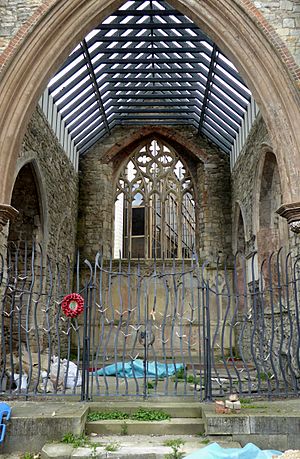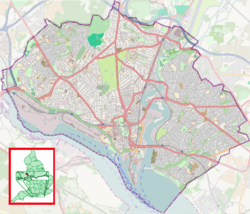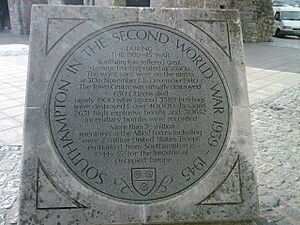Holyrood Church facts for kids
Quick facts for kids Holyrood Church, Southampton |
|
|---|---|

Holyrood Church, Southampton
|
|
| 50°53′59″N 1°24′13″W / 50.89966°N 1.40353°W | |
| Location | Southampton, Hampshire |
| Country | England |
| Denomination | Anglican |
| History | |
| Founded | 1320 |
| Dedication | Holy Cross |
| Architecture | |
| Functional status | Merchant Navy Memorial |
| Heritage designation | Listed building – Grade II* |
| Designated | 14 July 1953 |
| Architectural type | Church |
| Style | Medieval |
| Specifications | |
| Capacity | 974 (1851 Census) |
Holyrood Church (also known as Holy Rood Church) was one of the first five churches in the old walled town of Southampton, England. It was built in 1320. Sadly, the church was badly damaged by bombs during the blitz in November 1940.
In 1957, the remaining parts of the church were turned into a special memorial. It now honors the brave sailors of the Merchant Navy. Holyrood Church is recognized as a Grade II* listed building, which means it's a very important historical site.
Contents
History of Holyrood Church
Early Beginnings
The first mention of Holyrood Church was in 1160. This was when King Henry II gave control of several chapels, including Holyrood, to the monks of St. Denys. The church's name, "Holy Rood", comes from an old Saxon word. This suggests the church was built before the Norman conquest of England in 1066. If it had been built later, it would likely have been called "St. Cross".
The original church was located in the middle of High Street, which was then called "English Street". However, in 1320, the church was taken down. A new one was built on its current spot, on the eastern side of the road.
A Busy Town Center
During the Middle Ages, Holyrood Church was right in the heart of Southampton. It served as the main parish church for the southeastern part of the town. This made it a very important place for daily life.
Many famous people and groups visited the church. Crusaders stopped there on their way to the Holy Land. Soldiers prayed there before the Battle of Agincourt in 1415. Even Philip II of Spain visited in 1554. He was on his way to marry Queen Mary at Winchester Cathedral.
Changes Over Time
In 1801, a writer named Sir Henry Englefield described Holyrood Church. He noted that the outside had changed a lot. The tower was in an unusual spot at the south-west corner. He also mentioned a covered walkway, or colonnade, along the front. Locals called this walkway "the Proclamation."
Inside, the church was large and beautiful. However, the organ blocked the view into the chancel, which is the area around the altar. The church had old stained glass windows. There was also a fancy brass eagle desk.
By 1841, the organ had been moved. The church was described as a large, old building. It had a tower and a spire. It also had the "Proclamation" walkway. Inside, there were wooden screens and a nice font.
Restoration and Popularity
Between 1848 and 1849, the vicar, Reverend William Wilson, started to restore the church. He kept parts of the old 14th-century chancel and aisles. The south-west tower and spire were also kept. The wooden "Proclamation" walkway was taken down.
Reverend Wilson's hard work made Holyrood Church very popular. It changed from a quiet, old church to a busy one. In 1850, Philip Brannon wrote about the church's restoration. He said the inside looked "very fine." He praised the new look and the placement of the organ.
A census in 1851 showed that 974 people could sit in the church. On a typical Sunday, 462 people attended morning service. Another 405 came for the evening service. For the next 90 years, Holyrood Church was a beloved place. It was known as the "Church of the Sailors." People often gathered there to welcome the New Year.
World War II Destruction
On the night of November 30, 1940, German bombers attacked Southampton. This event is known as the Southampton Blitz. They dropped many bombs on the town center. During this attack, Holyrood Church was destroyed. It became a smoking ruin. Nearby St. Mary's church was also ruined. However, St. Michael's survived.
Southampton lost seven churches during the blitz. Many other buildings, homes, and shops were also destroyed. A beautiful brass lectern from Holyrood Church was saved from the ruins. It was later restored and is now in St. Michael's Church.
A Memorial to Sailors
In 1957, the ruins of Holyrood Church were repaired. They were then dedicated as a memorial to Merchant Navy seafarers. The ruins were also recognized as an ancient monument.
By 2004, the church ruins were in danger of collapsing. This was due to weather damage. A grant of £670,000 was given by the Heritage Lottery Fund. This money helped repair the tower and the chancel. New lights were also installed. These lights make the old church a beautiful sight in Southampton's night sky. The Merchant Navy Association also gave £5,000 for the repairs. This helped create a special place for sailors to remember their colleagues.
Holyrood Today
After the bombing in 1940, only parts of Holyrood Church remained standing. These include the tower on the south-western side and the chancel at the eastern end. Large sections of the north walls also survived. The wooden spire and the large west window were lost. The central part of the church was completely destroyed.
Features of the Ruins
On the west side of the tower, there is a special plaque. It honors Charles Dibdin (1745–1814). He was born in Southampton. He was a poet, writer, and composer. He wrote famous sea songs like "Tom Bowling."
Above the plaque are the clock and church bells. These bells have pre-1760 "Quarter jacks." These are small figures that strike the bells every 15 minutes.
Inside the church, under the tower, is a memorial fountain. It was built in 1912–13. This fountain remembers those who died when the RMS Titanic sank. The fountain used to be on Southampton Common. It is supported by four stone columns. Each side has carvings of the Titanic. A small dome with four columns sits on top.
In 2007, "audioposts" were added to the memorial. You can listen to historical recordings from these posts. These recordings give you an idea of what the church looked like before the war. They also share what the area meant to people.
A Place of Remembrance
The entire Holyrood Church ruin is dedicated to the brave men and women of the Merchant Navy. An annual Merchant Navy Day memorial service is held here. In one corner of the former main area, there is an anchor. Behind it, a plaque reads:
The church of Holyrood erected on this site in 1320 was damaged by enemy action on 30 Nov 1940. Known for centuries as the church of the sailors the ruins have been preserved by the people of Southampton as a memorial and garden of rest, dedicated to those who served in the Merchant Navy and lost their lives at sea.
As part of the 2004–06 improvements, artist Charles Normandale created beautiful metal screens and gates. These were made for the Chancel and the Titanic Memorial Fountain. The chancel now has a glass roof. Both the chancel and the main area are used for art shows and music events.
See also
- Holyrood estate




